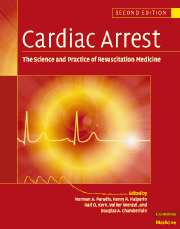Book contents
- Frontmatter
- Contents
- List of contributors
- Foreword
- Preface
- Part I Introduction
- Part II Basic science
- Part III The pathophysiology of global ischemia and reperfusion
- 12 The etiology of sudden death
- 13 Global brain ischemia and reperfusion
- 14 Reperfusion injury in cardiac arrest and cardiopulmonary resuscitation
- 15 Visceral organ ischemia and reperfusion in cardiac arrest
- 16 Mechanisms of forward flow during external chest compression
- 17 Hemodynamics of cardiac arrest
- 18 Coronary perfusion pressure during cardiopulmonary resuscitation
- 19 Methods to improve cerebral blood flow and neurological outcome after cardiac arrest
- 20 Pharmacology of cardiac arrest and reperfusion
- 21 Analysis and predictive value of the ventricular fibrillation waveform
- 22 Etiology, electrophysiology, and myocardial mechanics of pulseless electrical activity
- Part IV Therapy of sudden death
- Part V Postresuscitation disease and its care
- Part VI Special resuscitation circumstances
- Part VII Special issues in resuscitation
- Index
18 - Coronary perfusion pressure during cardiopulmonary resuscitation
from Part III - The pathophysiology of global ischemia and reperfusion
Published online by Cambridge University Press: 06 January 2010
- Frontmatter
- Contents
- List of contributors
- Foreword
- Preface
- Part I Introduction
- Part II Basic science
- Part III The pathophysiology of global ischemia and reperfusion
- 12 The etiology of sudden death
- 13 Global brain ischemia and reperfusion
- 14 Reperfusion injury in cardiac arrest and cardiopulmonary resuscitation
- 15 Visceral organ ischemia and reperfusion in cardiac arrest
- 16 Mechanisms of forward flow during external chest compression
- 17 Hemodynamics of cardiac arrest
- 18 Coronary perfusion pressure during cardiopulmonary resuscitation
- 19 Methods to improve cerebral blood flow and neurological outcome after cardiac arrest
- 20 Pharmacology of cardiac arrest and reperfusion
- 21 Analysis and predictive value of the ventricular fibrillation waveform
- 22 Etiology, electrophysiology, and myocardial mechanics of pulseless electrical activity
- Part IV Therapy of sudden death
- Part V Postresuscitation disease and its care
- Part VI Special resuscitation circumstances
- Part VII Special issues in resuscitation
- Index
Summary
Introduction
The resurgence of resuscitation research in the 1970s and 1980s initially focused on the physiological mechanisms for systemic blood flow during closed chest resuscitation for cardiac arrest. At the same time, the importance of both myocardial and cerebral blood flow during cardiopulmonary resuscitation (CPR) became evident. Using contemporary, state-of-art techniques, investigators found that regional perfusion of vital organs occurs with closed chest compression CPR, but at substantially lower rates than that measured during normal sinus rhythm. Such studies have shown that standard anteroposterior chest compressions can, at best, provide 30% to 40% of normal cerebral blood flow levels. Myocardial blood flow achieved with external chest compressions is often even lower, typically between 10% and 30% of normal. Peripheral perfusion is almost non-existent during CPR. Nevertheless, good CPR efforts can temporarily provide at least some perfusion to the myocardium and cerebrum until more definitive treatment (i.e., defibrillation) can be accomplished.
Myocardial perfusion during cardiac arrest can be estimated by measuring “coronary perfusion pressure” during the resuscitation effort. This perfusion pressure gradient correlates well with resultant myocardial blood flow generated with CPR and with the subsequent possibility of successful defibrillation. The critical importance of coronary perfusion pressure during CPR has been confirmed in both laboratory and clinical studies of resuscitation. This part of the chapter focuses on coronary perfusion pressure during CPR: its generation and impact.
Determinants of coronary perfusion pressure during cardiopulmonary resuscitation
AoD pressure during CPR
The importance of anadequate perfusion pressure for resuscitation from cardiac arrest was first noted by Crile and Dolley in 1906.
- Type
- Chapter
- Information
- Cardiac ArrestThe Science and Practice of Resuscitation Medicine, pp. 369 - 388Publisher: Cambridge University PressPrint publication year: 2007
- 2
- Cited by



